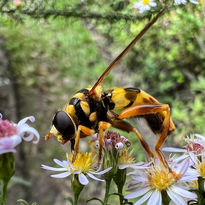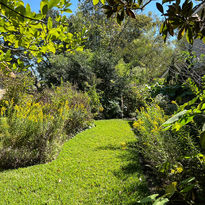
Common Questions About Native Plants
What are you curious about?
What are native plants?
ANPP defines natives as the plants that were already growing in Acadiana before Europeans arrived. For example, rattlesnake master (Eryngium yuccifolium) has been a component of the coastal prairie for millenia. It not only supports a large number of native sweat bee pollinators, but it was also valued as material used by indigenous people as a fiber. Shoes made of this plant were traded all the way to the Western US.
Non-native, or “introduced”, plants were brought to North America from other parts of the world by settlers. They brought their favorite food, medicinal and practical household plants. They continued to breed desirable characteristics, including beauty. Some of our favorite landscaping plants are roses, azaleas and crape myrtles. All have been bred by hobbyist gardeners for centuries. They are long-lived, beautiful and inexpensive to produce. But they provide very little in terms of ecosystem services considering how much space we give them in our landscaping.
How is a native garden different from a traditionally landscaped yard?
It may not be obvious, since many of the same rules apply to both: keep neat edges, consider layers, seasons and textures. Most native gardens include at least some lawn. What native gardeners aim to do, however, is to replace traditional introduced and cultivated plants with plants native to our region that support wildlife, including pollinators like native bees (not honeybees), diverse butterfly and moth species (not just monarchs), many different bird species (songbirds to wading birds to raptors). Most native gardeners do have some traditional cultivars, so very few are purists.
To support this diversity, native gardeners minimize use of fertilizers, watering regimes and pesticides, relying instead on ecological balance. Most native gardeners reduce the size of their lawn over time to only what they will use, since turf grass offers very little in wildlife and water management value and requires a lot of upkeep.
What’s so bad about plants from my local nursery?
There is nothing wrong with most plants from your local nursery. They just don’t add much ecological value to the little land we have left. Nurseries are businesses. They provide plants that appeal to their clientele. They are mass-produced inexpensively and distributed to smaller nurseries for finishing and shipping to your local garden store. These plants have been bred for particular and predictable characteristics of beauty, flowering, hardiness, stature, and transportability. Gardeners value this! However, these selection practices profoundly change the biology of these plants. The loss of natural selection has caused cultivars to become dependent on humans. Many cultivars don’t thrive and reproduce on their own without human intervention (and an entire industry that sells enabling life support like fertilizers, soil mixes and pesticides). Many have been treated with systemic insecticides that persist and kill the very insects that are so important in our ecosystems. Ask before you buy! Native plants, on the other hand, are toughened by time in real ecosystems. They retain the fertility, insect relationships, defenses, flood and drought tolerance of their ancestors, generation after generation. They evolved in our climate and soils with microbes. Natives have a great combination of the right stuff. Another casualty of horticultural practice is loss of characteristics insects and other animals count on. Cultivars often lose special characteristics of flower anatomy or nectar chemistry, causing insects to no longer recognize the plant or to be inadequate for ecosystem service. With herbivorous insects near the base of the food chain, their absence makes the ecosystem unable to support higher level consumers like birds, amphibians and mammals. It takes 6000 caterpillars to feed one clutch of chickadees by two parents foraging for 2-3 weeks. Without this level of insect production, it is no wonder that bird populations have crashed in the US since the 1970s. Our landscaping choices are as much to blame as pesticides. Breeding for one set of desirable characteristics is often a trade-off that leads to loss of seed fertility and genetic diversity. Plants produced in the horticultural trade are often genetic clones. This is an efficient, predictable business-oriented compromise. However, the lack of diversity sacrifices fertility and sustainability in nature. Even with pollinators present and active, genetically identical plants often do not reproduce well together. You may have noticed that the popular, but introduced, azaleas rarely attracts insects and never produces fruit or seeds. This severely curtails its ecological value. Azaleas are eye candy in gardens, not ecological workhorses. Even the ever popular (from India) crape myrtle has limited value. Some bird species do use its seed, but its seed is infertile and does not produce more crape myrtles. There are very good native alternatives to classic nursery plants.
What do nativar, invasive and aggressive mean?
Some niche growers in the horticulture industry have recognized the need to safeguard fertility, diversity and wildlife value. They have responded by breeding desirable horticultural characteristics in native species, such as flowering, short stature, fullness, color. These nativars are more and more available in traditional nurseries and even big-box garden centers. They are a better choice than introduced plants, but not as good as plants native to our region locally grown from wild-pollinated seed or genetically diverse cuttings. It is true that some introduced plant species have made themselves quite at home here in the region. Over a few centuries, some less particular insects and birds have come to use these naturalized species. However, some of these naturalized species have ignored nature’s safeguards and have become invasive. They flout the ecological barriers that evolved here and become pests. In Louisiana, the most wanted invasive species that should never be propagated or purchased are Japanese honeysuckle, Chinese tallow (chicken) tree, Japanese climbing fern, Chinese privet, nandina, water hyacinth. Other states are battling different invasives: Bradford (Callery) pear and kudzu. Never buy, propagate or share these plants. There are so many in the wild that you can feel comfortable actively controlling their spread on your property. The entire list of native plants and animals in Louisiana can be found on pages 408-414 in the LDWF Wildlife Action Plan.
Can native plants be invasive?
Botanists we talk to say no. However, we do have some aggressive native species here in Louisiana that are able to exploit disturbed soil (the definition of a weed) and extra light provided by edges. These “pioneer” natives can and should be controlled by introduction of more diversity and reduction of soil disturbance: poison ivy, blackberry, peppervine. They should not be eradicated, as they do have great wildlife value.
Ecosystems are complex. Much more than the individual plants and animals. Their relationships matter. Disruptions from human activity challenge ecosystem health everywhere. We cannot recreate or engineer this complexity since we don’t yet know all the interactions that evolved between all the living things right here in Acadiana.
But we do know a lot. Louisiana has been home for decades to some of the most respected voices of the American native plant movement. Those voices include great naturalists like Caroline Dormon and Bill Fontenot, and experts like Charles Allen, Malcolm Vidrine, Larry Allain, and Marc Pastorek who made preservation and restoration of our natural landscapes and native species their life’s work. Their blogs and publications are must-reads, with levels of helpful detail this website can’t approach. We always share notices of their public talks and workshops. Entomologist Douglas Tallamy has echoed their call and reinspired our nation to plant and replant our cities and suburbs with natives in patterns that mimic natural plant communities to support wildlife. Learn more with his full lecture on YouTube (below).
We’re here to help you learn how to plant and maintain natives in ways that beautify your garden, make it more resilient and provide numerous ecosystem services that traditional gardens and agriculture cannot.
Did you know?
These plants found commonly in south Louisiana are not native to the United States.

Roses
Most rose species are native to Asia and able to hybridize easily, making it difficult to pinpoint true origin.

Crape Myrtles
Crape myrtles were introduced from East Asia and are now planted in massive numbers across the South.

Azaleas
Most evergreen azaleas originated in Japan, but the infamous Encore Azalea brand began in 1990.




















